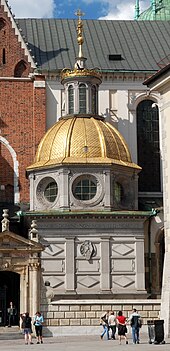Barbara Zápolya
| Barbara Zápolya | |
|---|---|
Grand Duchess consort of Lithuania | |
| Tenure | 8 February 1512 – 2 October 1515 |
| Coronation | 8 February 1512 Wawel Cathedral |
| Born | 1495 Trencsén, Kingdom of Hungary (most likely) |
| Died | 2 October 1515 (aged 19–20) Kraków |
| Burial | 18 October 1515 |
| Spouse | |
Zápolya | |
| Father | Stephen Zápolya |
| Mother | Hedwig of Cieszyn |
Barbara Zápolya (
Marriage plans
She was the daughter of
In August 1506,
Wedding

In April 1511, Sigismund sent
On 6 February 1512, Sigismund met Barbara in Łobzów, now a
Queen of Poland and Grand Duchess of Lithuania

Despite the age difference, the marriage was happy. The couple traveled together, even when Barbara was late in her pregnancy.
During that time, they exchanged frequent letters (20 letters by Sigismund and only two letters by Barbara survive) expressing their warm feelings for each other.[9] Sigismund particularly expressed his affection for Barbara and concern for her well-being, reminding her to take good care of her health and encouraging her to keep up her spirits.<[10] Contemporary sources almost universally praised Barbara for her virtues. Marcin Bielski wrote of her devotion to God, obedience to husband, kindheartedness and generosity to paupers.[11] Marcin Kromer even attributed the victory at Orsha to her Catholic piety and devotion, while Justus Ludwik Decjusz did not doubt that Barbara would join ranks of saints in the heaven.[11]
Despite her husband's affection and public support, Barbara did not have a strong political influence. For example, her mother and brother urged her to prevent
Their second daughter Anna was born on 1 July 1515.
Ancestors
| Ancestors of Barbara Zápolya | |||||||||||||||||||||||||||||||||||||||||||||||||||||||||||||||||||||||||||||||||||||||||||||||||||||||||||||||||||||
|---|---|---|---|---|---|---|---|---|---|---|---|---|---|---|---|---|---|---|---|---|---|---|---|---|---|---|---|---|---|---|---|---|---|---|---|---|---|---|---|---|---|---|---|---|---|---|---|---|---|---|---|---|---|---|---|---|---|---|---|---|---|---|---|---|---|---|---|---|---|---|---|---|---|---|---|---|---|---|---|---|---|---|---|---|---|---|---|---|---|---|---|---|---|---|---|---|---|---|---|---|---|---|---|---|---|---|---|---|---|---|---|---|---|---|---|---|---|
| |||||||||||||||||||||||||||||||||||||||||||||||||||||||||||||||||||||||||||||||||||||||||||||||||||||||||||||||||||||
References
- Notes
- ^ a b c d e f g Duczmal 2012, p. 79.
- ^ a b c Duczmal 2012, p. 81.
- ^ a b c Duczmal 2012, p. 80.
- ^ a b c d Duczmal 2012, p. 82.
- ^ "International Exhibition "Portraits of the Rulers and Magnates of the Grand Duchy of Lithuania from Museums in Ukraine"". National Museum – Palace of the Grand Dukes of Lithuania. 2012-09-03. Retrieved 2014-11-11.
- ^ Duczmal 2012, pp. 82–83.
- ^ a b c d e f g h Duczmal 2012, p. 83.
- ^ a b c d Duczmal 2012, p. 84.
- ^ a b c d e Duczmal 2012, p. 85.
- ^ Duczmal 2012, pp. 85, 87.
- ^ a b Duczmal 2012, p. 87.
- ^ a b c Duczmal 2012, p. 86.
- ^ Duczmal 2012, pp. 86–87.
- ^ Duczmal 2012, pp. 550–551.
- ^ Duczmal 2012, pp. 85–86.
- Bibliography
- Duczmal, Małgorzata (2012). Jogailaičiai (in Lithuanian). Translated by Birutė Mikalonienė; Vyturys Jarutis. Vilnius: ISBN 978-5-420-01703-6.
